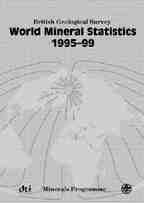Demand for base metals increased in 1999, according to World Mineral Statistics 1995-1999, a compilation of mineral and metals data published by the British Geological Survey (BGS).
Copper and zinc fared especially well in 1999. The red metal benefitted from increased consumption of electronic goods; zinc, from an increase in the use of steel coatings. Lead, despite having been replaced in many applications as a result of environmental concerns, remained at a steady level of demand because of its use in lead-acid storage batteries.
Output of aluminum and magnesium also increased, partly because automobile manufacturers wanted to decrease the weight of their products.
On the downside, steel demand, and thus iron ore production, continued to fall in all countries except China. Worldwide coal production also dropped, reflecting diminished output from China, the largest producer.
The Keyworth, U.K.-based BGS has been keeping records on the mineral industry since 1913.
The publication sells for about $225 and includes data on most economically important and internationally traded mineral commodities. The BGS also publishes a report called World Mineral Statistics Europe, which sells for about $70.
For more information, visit the web site at www.bgs.ac.uk


Be the first to comment on "Copper, zinc demand rose in ’99"